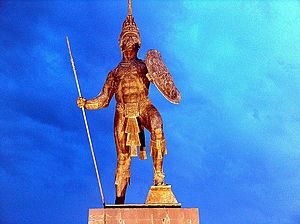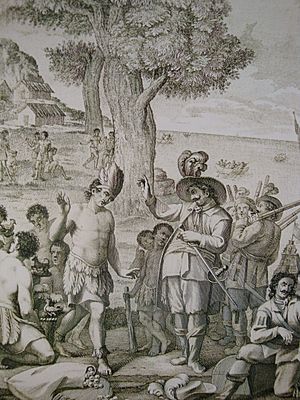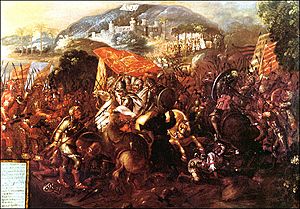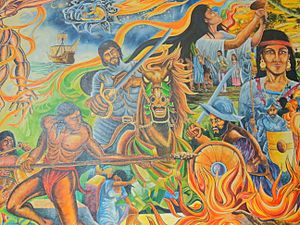Potonchán facts for kids
Potonchán was an important city of the Chontal Maya. It was the capital of a small kingdom called Tavasco or Tabasco. The city was located on the left bank of the Tabasco River, which the Spanish later renamed the Grijalva River. This area is now part of the Mexican state of Tabasco.
Juan de Grijalva arrived at Potonchán on June 8, 1518. He named the river after himself. Grijalva met with the Maya chief Tabscoob. It is said that Grijalva gave the chief his green velvet jacket as a gift.
Later, on March 12, 1519, the Spanish explorer Hernán Cortés arrived. Unlike Grijalva, Cortés was met by the native people ready for battle. This led to a big fight known as the Battle of Centla. After the Maya were defeated, Cortés built the first Spanish settlement in New Spain. He named it Santa María de la Victoria, and it was built right on top of Potonchán.
Contents
What Does Potonchán Mean?
The name Potonchán comes from the Nahuatl language. One idea is that "pononi" means "smell" and "chan" means "place." So, it could mean "place that smells."
Another idea, which many think is more likely, is that "poton" comes from the name the Chontal Maya called themselves: the Putún Maya. They were also known as Poton. So, Potonchán most likely means "Poton place" or "place of the Poton people."
Where Was Potonchán Located?
Potonchán was built on the left bank of the Tabasco River (now the Grijalva River). According to the writings of Bernal Diaz del Castillo, it was about a league (a few miles) from the coast.
The city sat on a small sandstone hill. It was almost completely surrounded by water. The river was on one side, and swamps were on the other two sides. This area was mostly flat land that often flooded.
Potonchán was the main city of the Tabasco kingdom. It was one of two major cities for the Chontal Maya. The other was Itzamkanac, the capital of Acalán. Unlike Itzamkanac, which was deep in the jungle, Potonchán was a port city. It was important for both sea and river trade. This allowed it to trade a lot with towns in the Yucatán Peninsula and with cities in the central highlands.
The Chontal Maya were very good at using their natural surroundings. They used the rivers as highways for travel and trade. They were skilled sailors and merchants. They controlled many sea routes around the Yucatán Peninsula. Their trade routes stretched from the Laguna de Términos in Campeche all the way to Sula in Honduras.
Near the border of what are now Tabasco and Campeche, there was a Mexica port called Xicalango. Potonchán and Xicalango often fought over control of the land. Potonchán won the last big war just before 1512. As a tribute, the people of Xicalango gave several women to Chief Tabscoob. One of these women was Malintzin, also known as "La Malinche". She was later given to Cortés after the Battle of Centla in 1519.
How Many People Lived in Potonchán?
Most of what we know about Potonchán comes from the writings of Spanish conquistadors. It was one of the most populated Maya cities in the Tabasco area. Juan Díaz, who wrote an "Itinerary," said that when Juan de Grijalva arrived in 1518, the city had "more than two thousand Indians..."
Bernal Diaz del Castillo, in his book Historia verdadera de la conquista de la Nueva España, wrote that when they reached Potonchán, there were "over twelve thousand warriors ready to attack [in the main square]." He also said the riverbank was "full of Indians in the bushes...."
Peter Martyr wrote that "the great city flanks the river of Tabasco, so great that it has twenty-five thousand houses..." These descriptions give us an idea of how large Potonchán was. They also show how many people lived there and in the nearby towns it controlled.
The city was very busy. Most of the houses were made of adobe (a type of mud brick).
Potonchán was a hub for trade. It had a lot of commercial activity. By sea, Potonchán traded with towns like Guazacualco, Xicalango, Chakán Putum, and Kaan Peech. It also traded with Maya areas like Acalán and Mazatlán. These were located in the jungles near the current borders of Tabasco, Campeche, and Guatemala. This trade even reached the port of Nito on Guatemala's Atlantic Coast.
We don't know much about the city's layout. Many buildings were made of natural materials like hedgerows and palm leaves. Also, many remains disappeared when the Spanish built Santa María de la Victoria on top of the old city.
A historian from Tabasco, Manuel Gil Saenz, reported that around 1872, near the port of Frontera, people found old columns, idols, jars, vases, and even pyramid ruins during logging work.
History of Potonchán
When Was Potonchán Founded?
We don't know the exact date Potonchán was founded. However, it was created after a split between the Maya of Mayapan and the Chontal Maya. The Chontal Maya formed their own kingdom, with Tabscoob as its leader. He ruled as the chief or lord of Tabasco.
The Chontal Maya had their own customs and laws. They used the same government system that existed before the collapse of the larger Maya empire. This system had three social classes: nobles and priests, people who paid tribute, and slaves. This continued until Hernán Cortés arrived in 1519.
Juan de Grijalva's Visit in 1518
The first Spanish group to reach Tabasco was led by Juan de Grijalva. On June 8, 1518, he discovered this land for the Western world. Grijalva arrived at the mouth of a large river. His crew named it "Grijalva" to honor him.
Juan de Grijalva decided to sail up the river to explore inland. He saw four canoes full of Native Americans. They were painted and making gestures of war. They showed they were not happy about his arrival. But Grijalva sent his interpreters, Julián and Melchorejo, to explain in the Maya language that they came in peace. They continued up the river and soon found the city of Potonchán.
"We started on June 8, 1518. Sailing armed along the coast, about six miles from land, we saw a very large stream of water coming from a major river. The fresh water flowed about six miles out to sea. Because of this current, we could not enter the river, which we named the Grijalva River. We were followed by more than two thousand Indians, who were making signs of war (...) This river flows from very high mountains, and this land seems to be the best the sun shines upon; if it were more settled, it would be a good capital: it is called the Potonchán province."
—Juan Díaz, Itinerary of Grijalva (1518)
Once ashore, Juan de Grijalva used his Maya interpreters to start a friendly conversation. He gave the native people gifts. Grijalva asked them to call their chief to meet with him. After a while, Chief Tabscoob arrived with his nobles to greet Grijalva. During their talk, they exchanged gifts. Tabscoob gave Grijalva some gold plates shaped like armor and some feathers. Grijalva gave the Maya chief his green velvet jacket.
Tabscoob told the Spanish captain about a place called Culua, "toward where the sun set..." He said there was much more gold there. Grijalva, in turn, spoke politely with the Maya chief. He said he came in the name of a great lord named Charles V. He explained that Charles V was a good ruler and wanted them as his subjects. Tabscoob replied that they were happy as they were. He said they did not need another lord. He also said that if Grijalva wanted to remain friends, his group should leave. Grijalva then got water and supplies and sailed toward Culua (modern-day San Juan de Ulúa).
Hernán Cortés's Arrival in 1519
Almost a year later, on March 12, 1519, the Spanish explorer Hernán Cortés arrived at the mouth of the Grijalva River. He ordered his ships to anchor. Then, he entered the river in small boats called skiffs. He was looking for the large city of Native Americans that Juan de Grijalva had described.
Cortés landed right at the river's mouth, at a place called "Punta de los Palmares."
"On the twelfth day of March in the year one thousand five hundred nineteen, we arrived at the Grijalva river, which is called Tabasco(...) and in the skiffs we all went to disembark at the Punta de los Palmares," which was near the town of Potonchán or Tabasco, about half a league away. They walked along the river and on the shore among bushes, which were full of Indian warriors(...) and so, there were more than two thousand warriors gathered in the village, ready to make war with us..."
—Bernal Díaz del Castillo, Historia Verdadera de la Conquista de la Nueva España (1519)
To find out what the native people intended, Cortés used a translator. He told some Native Americans in a boat that "he would do no harm to those who came in peace and that he only wanted to speak with them." But Cortés saw that the native people were still threatening. So, he ordered weapons brought to the boats. He gave them to archers and musketeers. He then began to plan how to attack the town.
The next day, March 13, 1519, the chaplain Juan Díaz and Brother Bartolomé of Olmedo held the first Christian mass in the continental territory of New Spain. After this, Cortés sent Alonso de Ávila with one hundred soldiers on the road to the village. Cortés and another group of soldiers went in the boats. On the shore, Cortés made a formal request, called a "requerimiento," in front of a king's notary named Diego de Godoy. He asked permission to land. This was the first official legal act in Mexico.
The native people refused. They told the Spanish that if they landed, they would be killed. They began to shoot arrows at Cortés's soldiers, starting the fight.
"... and they surrounded us with their canoes with such a spray of arrows that they made us stop with water up to our waists. There was so much mud that we could hardly get out. Many Indians charged us with spears and others pierced us with arrows, making sure we did not touch land as soon as we would have liked. With so much mud, we couldn't even move. Cortés was fighting and lost a shoe in the mud, coming to land with one bare foot(...) and we were upon them on land, crying to St. James, and we made them retreat to a wall made of timber. We breached it and came in to fight with them(...) we forced them through a road and there they turned to fight face-to-face, and they fought very bravely...."
—Bernal Díaz del Castillo, Historia Verdadera de la Conquista de populationla Nueva España (1519)
Alonso de Ávila arrived at the fight in Potonchán with his hundred men who had traveled by land. This made the Native Americans flee and hide in the mountains.
In this way, Cortés took control of the large main square of Potonchán. It had rooms, large halls, and three houses of idols.
"...we came upon a great courtyard, which had some chambers and great halls, and had three houses of idols. In the "cúes" [temples] of that court, which Cortés ordered that we would repair (...) and there Cortés took possession of the land, for his Majesty and in his royal name, in the following manner: His sword drawn, he dealt three stabs to a large ceiba tree in a sign of possession. The tree was in the square of that great town and he said that if there were one person that contradicted him, he would defend it with his sword and all those that were present said it was okay to take the land (...) And before a notary of the king that decree was made... "
—Bernal Díaz del Castillo, Historia Verdadera de la Conquista de la Nueva España (1519)
The Battle of Centla
The next day, Captain Cortés sent Pedro de Alvarado with a hundred soldiers. He was to go about six miles inland. Cortés also sent Francisco de Lugo with another hundred soldiers to a different area. Francisco de Lugo soon met groups of warriors, and a new battle began. When Alvarado heard the shots and drums, he went to help Lugo. Together, after a long fight, they managed to make the native people flee. The Spanish soldiers then returned to town to tell Cortés.
Hernán Cortés learned from a captured Native American that the people would attack the town. So, he ordered all the horses to be unloaded from the ships. He also told his soldiers to prepare their weapons.
The next morning, Cortés and his men went across the plains to Cintla or Centla. These were towns under Potonchán's control. The day before, Alvarado and Lugo had fought against the native people there. In Centla, they found thousands of Native Americans, and the Battle of Centla began.
The Chontal Maya attacked the Spanish. The Spanish defended themselves with firearms like muskets and cannons. These weapons scared the Native Americans. But what terrified them even more was seeing the Spanish cavalry (soldiers on horseback). They had never seen horses before. The Native Americans thought that the rider and the horse were one single creature. In the end, the Native Americans lost, mainly because the Spanish had more advanced weapons.
"... And we came upon them with all the Captaincies and squads. They had departed in search of us, and they brought great plumes, drums and small trumpets. Their faces were red with ochre, pale and dark. They had great bows and arrows and spears and bucklers (...) and they were in such large squads that all the savanna was covered. They came furiously and surrounded us on all sides. The first attack wounded more than seventy of us, and there were three hundred Indians for each one of us (...) and being in this, we saw how the cavalry came from behind them and we trapped them with them on one side and we on the other. And the Indians believed that the horse and the rider were one, as they had never seen horses before..."
—Bernal Díaz del Castillo, Historia Verdadera de la Conquista de la Nueva España (1519)
After the battle, Cortés and his men returned to Potonchán. There, they treated the wounded and buried the dead. The next day, Chief Tabscoob sent ambassadors to the Spanish camp with gifts. According to their tradition, the loser had to give gifts to the winner. Among the gifts were gold, jewelry, jade, turquoise, animal skins, domestic animals, and feathers from beautiful birds.
The Native Americans also gave the Europeans 20 young women. One of these women was called Malintze, Malintzin, or Malinalli by different sources. The Spanish named her Doña Marina. She became a very important helper and translator for Cortés. Later, Cortés had a son with her.
See also
 In Spanish: Potonchán para niños
In Spanish: Potonchán para niños






